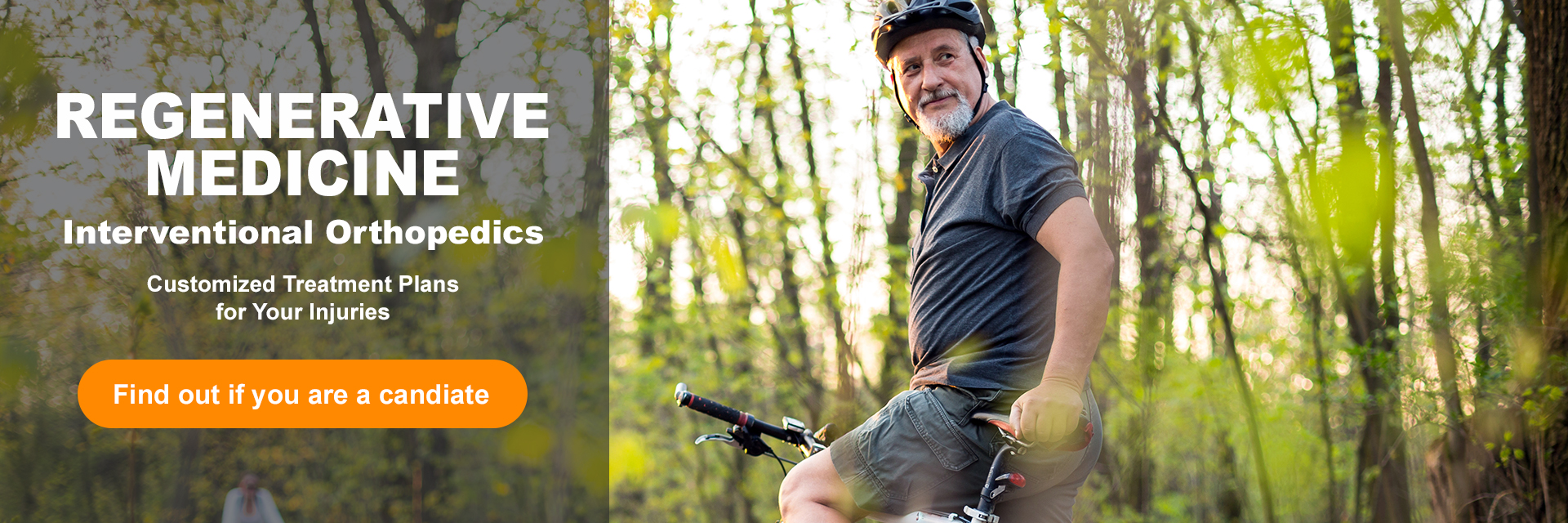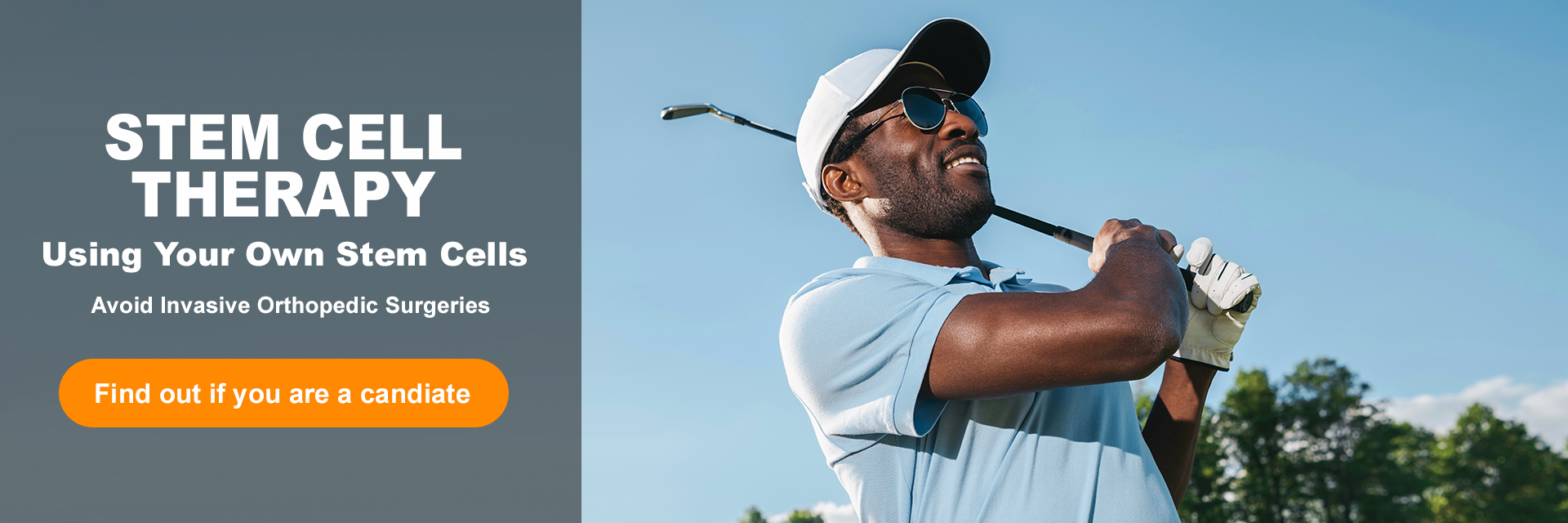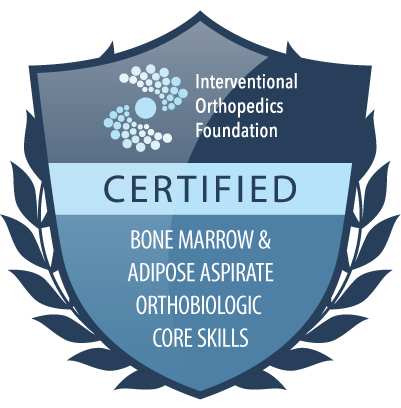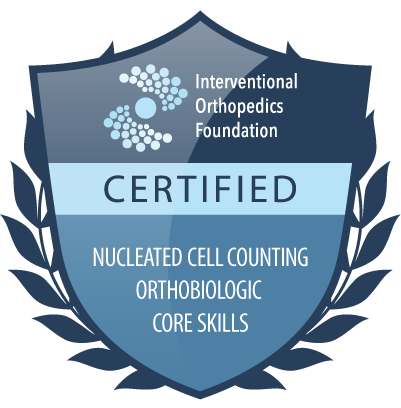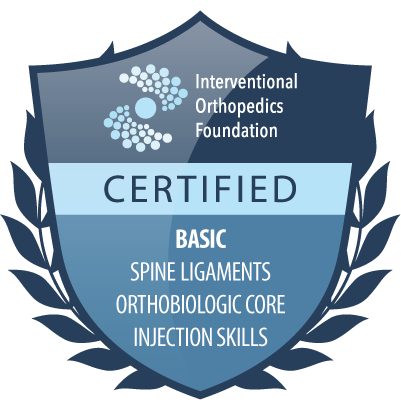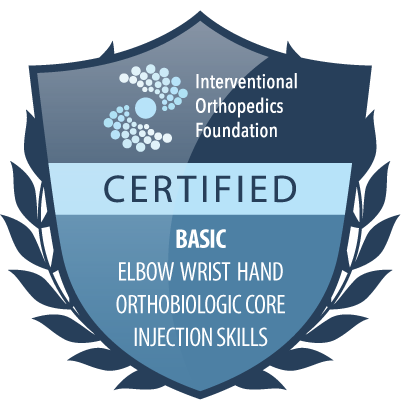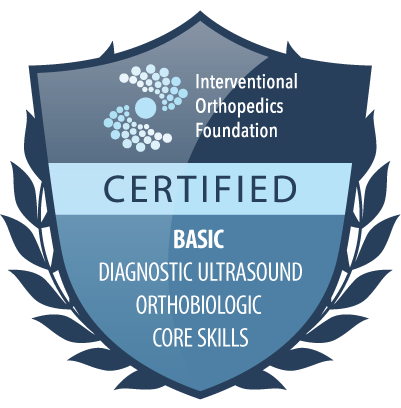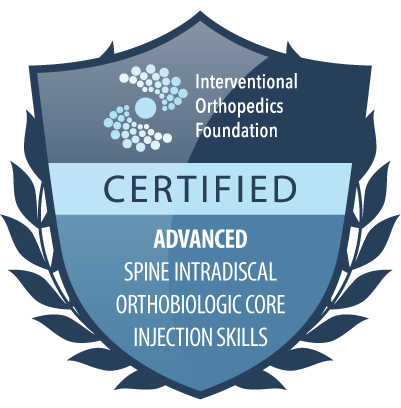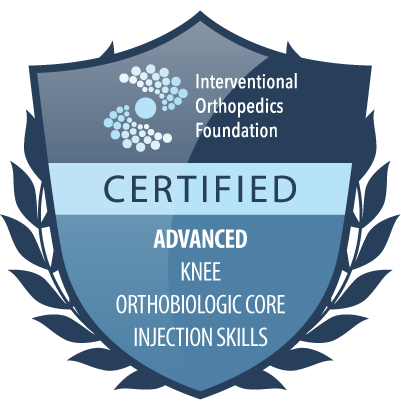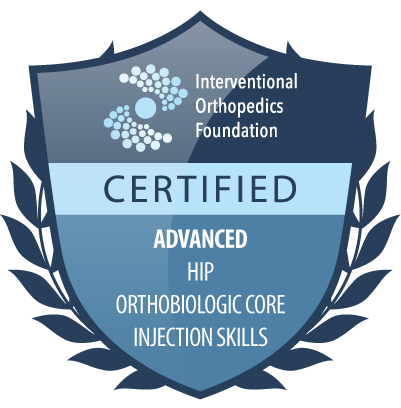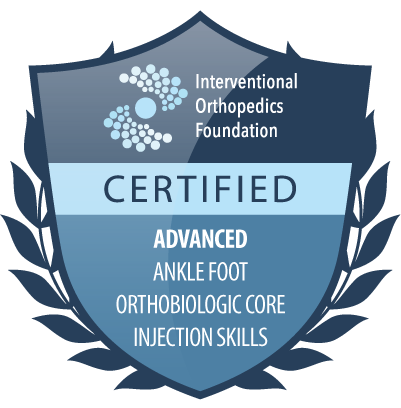Cell-based therapy is making critical advances that allows us to offer you cutting edge treatments for orthopedic injuries and pain. PRP and bone marrow stem cells have the innate ability to heal, and precise injections of these cells to areas of orthopedic injuries can help you avoid surgery and decrease your pain. The use of PRP and stem cells offer promising solutions to treat pain from chronic conditions like bone and cartilage degeneration, tendon and ligament damage, torn muscles, osteoarthritis, nerve damage, degenerative joints and degenerative discs of the spine.
The entire PRP procedure, including blood draw, preparation of the cells for injection, and image guided injection, will usually take under an hour. The bone marrow stem cell procedure will take a little longer, but will usually be done in less than 2 hours. Some patients respond very well to one treatment, but other patients require 2 or 3 treatments to reverse the degenerative process causing injury. The protocols we have in place are designed to get the best response to a single treatment course over multiple visits, but if follow up injections are needed we will usually schedule them 2 to 3 months apart. This gives each series optimal time to decrease your pain and improve your function. Some degenerative processes, like severe hip arthritis, can be a more difficult process to treat, in which case we could decide from the onset to provide 2 or 3 PRP treatments about 1 month apart.
With overwhelmingly positive results, more controlled studies are underway around the world. A this time, treatment with these products are still considered experimental by the FDA.
A few key points:
1. Our physicians have unique training in Interventional Regenerative Orthopedic Medicine to provide injections with PRP and stem cells to treat orthopedic injuries and pain. The success of your treatment depends greatly on the training of the physician providing your care. We have specialized treatment protocols in place involving multiple visits to optimize your results.
2. At our clinic, we use FDA cleared devices to make the concentrated platelet rich plasma and stem cell rich bone marrow that we use to provide your regenerative treatments. Not all PRP and stem cell procedures are the same, and differences in concentrations play a crucial role. The success of your treatment depends greatly on the product used. If the device does not provide high quality PRP and stem cells, it is a waste of your time and money.
3. After consultation at our clinic, you will understand why we think you are a good, fair or poor candidate for these treatments, so you can make an informed and educated decision about pursuing regenerative treatment for your pain and dysfunction.
PRP therapy involves injection of a concentrated mix of your platelets and serum into injured areas of your body. You are probably familiar with the role of platelets in healing injuries that you can see, on the surface of your skin. They gather around the area of injury, form a clot to stop the bleeding, and then beneath the surface they help direct the healing process that takes place. This is the redness and swelling you observe, and this inflammation is a key first step to the way your body heals. The average platelet survives for about a week in your bloodstream, so when they stop at a site of injury they can provide a strong regenerative response over the course of that week.
The same thing happens to injuries that you can’t see, and may be unaware of, throughout your musculoskeletal system – in ligaments, tendons and muscles. As blood flows to the injured area, the platelets form a clot to stop the bleeding and help direct the healing process. Sometimes your body suffers serious injury or undergoes chronic degenerative changes to tissue over time – and you simply can’t sustain the necessary healing environment to fully recover. The chances of suffering from these unhealed injuries increases as you age. Luckily, providing targeted injections of concentrated PRP to these areas can restart and enhance the healing process!
So far, PRP treatments have been shown to be safe and effective when used to treat osteoarthritis of joints, damaged discs in the spine, as well as damaged tendons, ligaments and muscles.
The injection of concentrated platelets is effective because it leads to increased healing after stimulating a cascade of substances involving growth factors and cytokines, proteins and through stimulating local stem cells.
The entire PRP procedure, including blood draw, preparation of the cells for injection, and image guided injection, will usually take under an hour. The bone marrow stem cell procedure will take a little longer, but will usually be done in less than 2 hours. Some patients respond very well to one treatment, but other patients require 2 or 3 treatments to decrease pain and improve function. The protocols we have in place are designed to get the best response to a single treatment course over multiple visits, but if follow up injections are needed we will usually schedule them 2 to 3 months apart. This gives each series optimal time to decrease your pain and improve your function. Some injuries can be more difficult to treat, in which case we could decide from the onset to provide 2 or 3 PRP treatments about 1 month apart.
Stem Cells are amazing and unique cells. The adult mesenchymal stem cells are the ones used to help heal your orthopedic injuries, because they can transform into other cells like bone, cartilage, muscle and tendon. They also play a key role in the signaling process necessary to heal injured areas of your musculoskeletal system. So, unlike platelets that just direct the healing process calling for help from local stem cells, the mesenchymal stem cells we inject into an area of injury help direct the process AND can turn into the tissue that needs to be regenerated.
Injections using stem cell therapy should always be done under live guidance with an ultrasound or x-ray machine to make sure the cells are delivered precisely where they need to be and should always be done by a physician who is trained and certified to perform these precisely guided injections.
If we recommend stem cell treatment to help you heal an orthopedic injury, it is because we feel that PRP alone may not be enough. By concentrating stem cells from the bone marrow in your hip and adding them to the injured area, it can give this area the extra stem cells it needs to help reduce your pain and improve your function.
At our clinic we remain up to date at all times with the current guidelines regarding which cells should be used for your orthopedic care. At this time, the only cells that should be offered to you are cells obtained from your own bone marrow to treat orthopedic injuries. The other options are unproven and illegal to use unless you are enrolled in clinical trials regarding the use of stem cells.
Choosing a provider for your regenerative orthopedic care can be tricky, but it doesn’t have to be. There are chiropractic clinics, primary care clinics, orthopedic clinics, etc. all claiming they have the best treatment for your problems. The reason this is the case is because the use of these products is considered “off label,” so for now there is not as much regulation as there should be on who can provide these treatments. This has led to all types of providers offering these treatments, even if it is well outside their scope of practice. So here are a few questions you should ask your provider before considering treatment at their clinic:
1. Are you board certified to do injections at the area of my injury?
2. Do you use adult mesenchymal stem cells from my bone marrow for treatment?
3. Do you have an idea of how much you concentrate the platelets before injecting them into my body?
4. Do you use an FDA cleared device to concentrate my platelets or stem cells before injection?
5. Do you have any certifications and advanced training in the field of regenerative medicine?
6. Do you use x-ray and ultrasound guidance during the injection to see where you are placing the cells in my body?
7. Do you have customized treatment plans for my specific injury instead of a “one and done” injection?
The answer to all these questions is YES, if you come to our clinic for treatment.
In addition, the physicians at our clinic are certified to treat injuries of your spine AND joints, so you don’t need to have numerous different specialists struggling to coordinate your care.
The data on PRP and Stem Cells from your bone marrow, when used to treat orthopedic injuries, has been overwhelmingly safe. In addition to boosting your body’s ability to heal, the injections also have a positive effect on your immune system. In fact, regenerative medicine has also dramatically helped change the field of wound care for the better. Using the cells from your own body has shown in clinical studies that infection rates after these injections are even less than standard injections with steroids. Steroid or “cortisone shots” actually impair your healing, and decrease the immune system activity in your body.
At our clinic, we adhere to strict standards of sterile technique for all procedures.
WARNING: Many other clinics have adopted the use of “birth tissue” products because they come pre-packaged in a vial and are quick and easy to inject. However, there is no clinical data that “birth tissue” products are safe for injection. This includes products that are made from embryonic, placental, cord blood, wharton’s jelly and umbilical tissue. Actually, systemic allergic reactions have been reported from these products, and since they originate from someone other than yourself, there is risk for transmission of undetected infectious material. Be cautious when considering the injection of biologic material that is not from your own body!
Generally, PRP is used for mild to moderate tears and arthritis while Stem Cells are used for more severe injuries.
Below is a list of some of the injuries that can be treated with PRP and Stem Cell therapy.
Knee: Arthritis, Meniscus Tears, Tendon & Ligament Tears, Overuse Injuries and other degenerative conditions
Hip: Arthritis, Bursitis, Tendon and Ligament Tears, Labral Tears, Overuse Injuries and other degenerative conditions
Shoulder: Arthritis, Bursitis, Rotator Cuff Tears, Labral Tears, Overuse Injuries and other degenerative conditions
Spine: Degenerative, herniated and bulging discs, Arthritic Joints, Irritated Nerves
Hand & Wrist: Arthritis of the hand and CMC joint, Carpal Tunnel, other degenerative conditions
Foot & Ankle: Arthritis, plantar fasciitis, Achilles tendonitis, other degenerative conditions
Elbow: Arthritis, tennis elbow, golfer’s elbow, other degenerative conditions
Since the basis of these regenerative treatments is to restart and boost your body’s ability to heal, inflammation is an expected component of treatment – especially during the first few days after the injection. This is not to be confused with chronic, unhealthy inflammation associated with chronic injuries, diabetes and obesity. Therefor, avoiding the commonly used anti-inflammatory medications can significantly increase your chance of recovery since they will limit the inflammation triggered by these treatments that lead to tissue regeneration. Instead of anti-inflammatories, tylenol can be used for pain following the procedure.
In addition, ice reduces inflammation and swelling, so you do not want to use ice on the treated area as it will limit the healing process.
There is also more data coming out that commonly prescribed medications, like statins, decrease the stem cell count or their effectiveness. There’s no way that every medication will be studied any time soon to assess how it affects your stem cells, but patient’s on less daily medications would be expected to do better.
In addition, there are basic principles you should try to follow to help your body heal, with or without going through these treatments. These include good nutritional habits, staying hydrated, staying active and sleeping well. The food and water you take into your body are the fuel for your cells, and it is crucial you have a diet sufficient in protein, healthy fat, complex carbs and water. Vitamins and supplements like turmeric, fish oil, chondroitin and glucosamine may also help you heal. There is also a growing body of evidence about how exercise increases the effectiveness of key components of your cells – like mitochondria – and decreases the “age” of your cells. So stay active!
While it is possible to treat multiple different injuries, it is not recommended. The key component of treatment is the concentration of the platelets or stem cells and delivering them to the site of pain and injury. If we spread the cells out to many different areas, the chance of success is significantly less.

